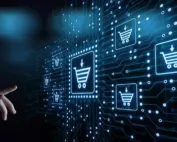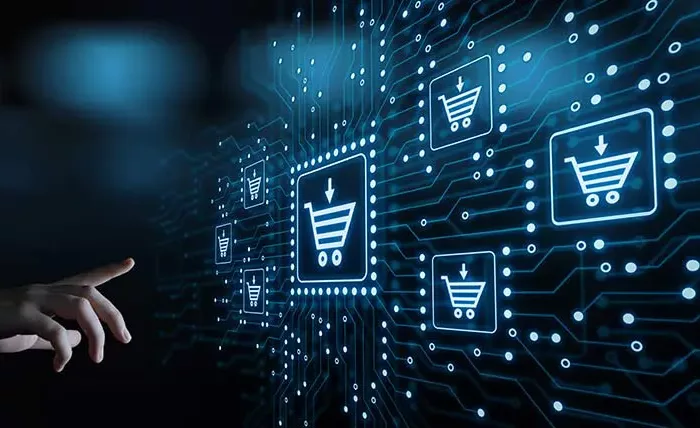Share
Author
George Anderson
Share
First published Jan 14, 2020. Revised and expanded May 16, 2023.
Personalization is essential in B2B ecommerce. In fact, 73% of B2B buyers want personalized experiences.
What’s more, 85% of B2B buyers will switch suppliers due to a bad digital experience.
Clearly, it’s essential to get personalization right.
But personalization presents unique challenges in B2B ecommerce. Most of the data and logic that define personalization already exist in the merchant’s SAP ERP system. (Pssst! You’ll want to keep that fact in mind as you compare B2B ecommerce platforms.)
How do you tackle these challenges?
Here’s our take on the 9 most essential forms of personalization—and how to provide them.
1. Personalized catalog
Manufacturers, wholesalers, and distributors often need to control which products a given customer is allowed to buy. This could be for regulatory reasons, strategic reasons, or a combination of the two. Since SAP ERP defines the customer’s allowed products, and a customer service rep can only place an order that conforms to these rules, it’s easy to handle this restriction for manual order entry processes.
But how do you map that complexity in personalized B2B ecommerce?
How to deliver a personalized B2B ecommerce catalog
The answer here is fairly simple. Choose a B2B ecommerce solution that’s built on a rock-solid integration with SAP ERP.
That’s how Corevist Commerce Cloud works. Whatever product restrictions apply to your customers in SAP, our solution enforces those same restrictions in B2B ecommerce.
In other words, your customers can only purchase the SKUs that your SAP business rules allow. It’s a simple, elegant solution to the problem of catalog personalization in B2B.
2. Personalized product recommendations
Related products are a crucial merchandising tool in B2C ecommerce. But they serve an additional function in B2B. While they can certainly help you grow your AOV (average order value), they also offer a powerful opportunity for personalization.
For example, if a customer has purchased a major piece of equipment from you, and you also sell consumables to support that equipment, you can leverage those product relationships in B2B ecommerce as recommended products for that customer. This empowers you to offer even more value in B2B ecommerce, reminding customers of the ancillary products that they may need to reorder to maintain that major piece of equipment.
How to deliver personalized product recommendations
If you’ve already defined these product relationships in SAP, then it doesn’t make sense to re-define them in your B2B ecommerce solution. You should look for a way to leverage that existing SAP logic directly without duplicating and synchronizing data between SAP and B2B ecommerce. (Hint: Corevist solves this with direct, real-time SAP integration built in.)
3. Personalized pricing
Not every customer gets the same pricing when buying from a manufacturer, wholesaler, or distributor. Contract pricing, including any quantity-based or scaled discount logic, is defined in SAP for each customer. If your buyers can’t get accurate pricing in B2B ecommerce, they simply won’t use the web store. They’ll have to call in anyway, which defeats the purpose of offering self-service online ordering.
So how do you get each customer’s pricing right in B2B ecommerce?
How to deliver personalized pricing
Since each customer’s unique pricing rules already exist in SAP ERP, you’ll need a B2B ecommerce solution that’s integrated to SAP. The solution also needs to map personalized pricing to the individual B2B ecommerce user.
Since Corevist Commerce Cloud is built on a direct integration to SAP, we provide personalized contract pricing to each of your customers, right out of the box. This prevents you from duplicating all those SAP business rules in B2B ecommerce.
4. Personalized, real-time inventory (or ATP)
What inventory information do you offer customers today? If they call or email customer service to ask about availability, what information do your reps provide?
Depending on your policies, each customer may need access to the actual total available inventory, or you may only provide them with an ATP (available to promise) quantity that’s calculated individually for each customer.
Whichever model you use, your customers need to know how much stock is available before they make a purchase. Our client InHealth Technologies experienced problems here, as their old B2B ecommerce platform couldn’t display inventory information. Customers had to place an order online, then call customer service to see if the stock was actually available.
This was frustrating for customers. It also created waste for InHealth Technologies, as their reps had to spend a lot of time checking inventory, communicating with customers, placing things on backorder, and updating available quantities in two places—SAP and the web store.
Clearly, you’ll need to address inventory display in B2B ecommerce in a way that conforms to your SAP business rules.
How to deliver personalized inventory/ATP
Once again, the best way to personalize inventory data in B2B ecommerce is to take it straight from SAP ERP, in real time.
This is how Corevist Commerce Cloud works. When it comes to stock availability, our solution acts as a window into your SAP system. We can display ATP/inventory availability in real time, personalized for each user—or suppress it entirely, if you prefer not to show inventory numbers in B2B ecommerce.
5. Personalized cart experience
What happens if a customer tries to order an SKU that they’re not allowed to buy?
What if they order a quantity of 8, when the material is only sold in multiples of 10?
What if the SKU they’ve ordered has actually been retired, and they should’ve ordered the SKU that replaces it?
Problems like these arise when your B2B ecommerce solution isn’t integrated to SAP. Chances are, you have business rules defined in SAP that handle most (if not all) of these situations.
The B2B ecommerce cart needs to reflect these business rules if it’s going to provide seamless personalization.
How to deliver a personalized cart experience in B2B ecommerce
If you’ve defined your product and customer rules in SAP, then your B2B ecommerce cart should reflect those rules. Pricing, inventory availability, and product permissions should be the same as in other parts of the application.
The B2B ecommerce solution should also give users personalized error messages so they can create well-formed orders. This is only possible through real-time SAP integration, and it’s exactly what Corevist delivers. When a user puts an order together, our solution simulates the order against the relevant SAP business rules in real time. If any errors occur, Corevist gives the user a personalized message explaining what’s wrong so they can fix it.
6. Personalized sold-to/sales area selection
If B2B ecommerce is going to work for manufacturers, wholesalers, and distributors, it needs to support complex relationships between ship-tos, sold-tos, and payers. It’s not enough to personalize the B2B ecommerce browsing experience. Every user needs access to personalized workflows that support their role within the transaction.
This is especially true when it comes to mapping multiple sold-tos and sales areas. If your current business processes allow users to place orders on behalf of multiple sold-tos or sales areas, then your B2B ecommerce solution needs to support that personalization.
Note: This is especially useful if you’re using B2B ecommerce as a sales portal for your reps to place orders on behalf of customers.
How to deliver personalized sold-to/sales area selection
Since the relationship between roles, sales areas, and sold-tos exists in SAP, it only makes sense to use an SAP-integrated B2B ecommerce solution to provide this personalization.
That’s how Corevist Commerce Cloud works. Whatever relationships exist between roles, sales areas, and sold-tos in SAP, Corevist maps those same relationships within your B2B ecommerce experience store. For example:
- A sales rep can use B2B ecommerce to place orders on behalf of each of his/her assigned customers, toggling between different customer accounts.
- A customer service rep can track down order status for each of his/her assigned customers.
- If your business rules allow, a customer can choose between multiple sold-tos or sales areas before placing an order.
7. Personalized tracking and payments
Here’s where many conventional B2B ecommerce platforms stumble. Without complex, expensive, custom integrations, they can’t deliver total self-service for post-order tasks like tracking orders and invoices, checking credit status, and paying off invoices.
It’s not enough to show order history and status for B2B ecommerce orders. Every customer has a history of orders placed through other channels. Some buyers may continue to place orders via phone, fax, email, or EDI. This means the B2B portal should show real-time status and history for orders from all channels, not just orders from B2B ecommerce. Any order that’s in SAP should appear in the tracking portion of the portal.
Customers don’t just need order tracking, either. They also need full invoice history, real-time open items and credit status, and—ideally—the ability to pay off open invoices online.
How to deliver personalized tracking and payments
Since every customer’s account data lives in SAP, you’ll need a comprehensive SAP integration to bring this level of personalization to B2B ecommerce. For information like credit status, order status, and open items, you really need real-time integration so this information never gets out of sync.
8. Personalized quote workflows
Quote workflows can get fairly complex. Some line items in a quote may get finalized before others. B2B ecommerce users need full control of the process, so they can convert finalized line items to orders if the overall quoting process is taking too long.
How to deliver personalized quote workflows
Since quotes ultimately live in SAP ERP, your B2B ecommerce solution will need to integrate deeply with SAP. Otherwise, you’ll end up with duplicate data for quotes, line items, and quotes converted to orders.
This is why Corevist Commerce Cloud includes full support for complex quote workflows—with deep SAP integration included. Learn more here: What’s New In Corevist Commerce Cloud – Q1 2023.
9. Personalized human-to-human chat experiences
Sometimes customers just need a human touch. They may have a question that really requires a human answer. You definitely want to meet them where they’re at with chat availability.
Human-to-human chat isn’t only beneficial for customers. It’s great for sellers, too. Visitors who are invited to chat are 6.3 times more likely to convert into customers. Meanwhile, 61% of those customers convert within the first chat.
Clearly, chatting is powerful—but it has to be personalized. Your agents have to know who they’re talking to, what products the customer has viewed, and more.
How do deliver personalized chat experiences
Corevist’s integration with LiveChat brings the power of real-time, human-to-human chat to your B2B ecommerce experience. Our integration ensures that every chat agent knows which customer they’re talking to (as defined in your SAP system), while LiveChat’s powerful functionality provides information like pages visited, location, and so on.
Learn more here: Corevist Introduces LiveChat Integration For B2B Ecommerce.










